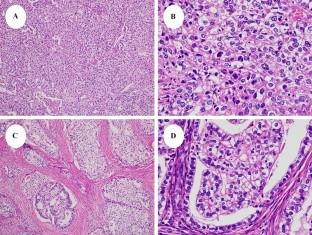Medical Molecular Morphology ( IF 1.2 ) Pub Date : 2022-10-02 , DOI: 10.1007/s00795-022-00336-7
Shu Kuriyama 1 , Mitsutake Yano 1, 2 , Takahiro Kusaba 3 , Sumika Zaitsu 1 , Haruto Nishida 3 , Masanori Yasuda 2 , Kaei Nasu 1, 4

|
Adenocarcinomas with clear cell morphology may be associated with elevated serum alpha-fetoprotein levels in various organs. We report the case of an alpha-fetoprotein-producing cervical adenocarcinoma with clear cell morphology and compare it immunohistochemically, molecularly, and virologically with cervical clear cell carcinoma, gastric-type mucinous carcinoma, and ovarian clear cell carcinoma. A 51-year-old Japanese woman was initially diagnosed with cervical clear cell carcinoma. The tumor was resistant to standard surgery, radiotherapy, and chemotherapy. Serum carcinoembryonic antigen and alpha-fetoprotein were elevated. The tumor was immunohistochemically positive for alpha-fetoprotein, human chorionic gonadotropin, cytokeratin 20, spalt-like transcription factor 4, glypican 3, MUC6, and HIK1083. Gene panel testing revealed CCNE1 amplification, CDKN2A loss, and TP53 R282W. We compared the present case with 120 ovarian clear cell carcinoma cases using a tissue microarray. Only one case (0.8%) showed very limited immunohistochemical positivity for alpha-fetoprotein. Of the 54 cases in which serum carcinoembryonic antigen was measured, only one (1.9%) was elevated (19.9 ng/mL). We diagnosed the case as alpha-fetoprotein-producing cervical gastric-type mucinous carcinoma with enteroblastic differentiation. In conclusion, alpha-fetoprotein-producing cervical adenocarcinoma is a rare but aggressive tumor. Clinicians and pathologists should be aware of this unfamiliar tumor, its diagnostic clues, prognostic markers, and treatment strategies.
中文翻译:

具有透明细胞形态的产甲胎蛋白宫颈腺癌的免疫组织化学和分子分析
具有透明细胞形态的腺癌可能与各种器官中升高的血清甲胎蛋白水平有关。我们报告了一例具有透明细胞形态的产甲胎蛋白宫颈腺癌病例,并将其与宫颈透明细胞癌、胃型粘液癌和卵巢透明细胞癌进行了免疫组织化学、分子学和病毒学方面的比较。一名 51 岁的日本女性最初被诊断出患有宫颈透明细胞癌。肿瘤对标准手术、放疗和化疗有抵抗力。血清癌胚抗原和甲胎蛋白升高。肿瘤对甲胎蛋白、人绒毛膜促性腺激素、细胞角蛋白 20、spalt 样转录因子 4、磷脂酰肌醇蛋白聚糖 3、MUC6 和 HIK1083 呈免疫组织化学阳性。基因面板测试显示 CCNE1 扩增、CDKN2A 丢失和 TP53 R282W。我们使用组织微阵列将本病例与 120 例卵巢透明细胞癌病例进行了比较。只有一例 (0.8%) 显示出非常有限的甲胎蛋白免疫组化阳性。在检测血清癌胚抗原的54例中,只有1例(1.9%)升高(19.9 ng/mL)。我们诊断该病例为伴肠母细胞分化的产甲胎蛋白宫颈胃型粘液癌。总之,产甲胎蛋白的宫颈腺癌是一种罕见但具有侵袭性的肿瘤。临床医生和病理学家应该了解这种不熟悉的肿瘤、它的诊断线索、预后标志物和治疗策略。我们使用组织微阵列将本病例与 120 例卵巢透明细胞癌病例进行了比较。只有一例 (0.8%) 显示出非常有限的甲胎蛋白免疫组化阳性。在检测血清癌胚抗原的54例中,只有1例(1.9%)升高(19.9 ng/mL)。我们诊断该病例为伴肠母细胞分化的产甲胎蛋白宫颈胃型粘液癌。总之,产甲胎蛋白的宫颈腺癌是一种罕见但具有侵袭性的肿瘤。临床医生和病理学家应该了解这种不熟悉的肿瘤、它的诊断线索、预后标志物和治疗策略。我们使用组织微阵列将本病例与 120 例卵巢透明细胞癌病例进行了比较。只有一例 (0.8%) 显示出非常有限的甲胎蛋白免疫组织化学阳性。在检测血清癌胚抗原的54例中,只有1例(1.9%)升高(19.9 ng/mL)。我们诊断该病例为伴肠母细胞分化的产甲胎蛋白宫颈胃型粘液癌。总之,产甲胎蛋白的宫颈腺癌是一种罕见但具有侵袭性的肿瘤。临床医生和病理学家应该了解这种不熟悉的肿瘤、它的诊断线索、预后标志物和治疗策略。在检测血清癌胚抗原的54例中,只有1例(1.9%)升高(19.9 ng/mL)。我们诊断该病例为伴肠母细胞分化的产甲胎蛋白宫颈胃型粘液癌。总之,产甲胎蛋白的宫颈腺癌是一种罕见但具有侵袭性的肿瘤。临床医生和病理学家应该了解这种不熟悉的肿瘤、它的诊断线索、预后标志物和治疗策略。在检测血清癌胚抗原的54例中,只有1例(1.9%)升高(19.9 ng/mL)。我们诊断该病例为伴肠母细胞分化的产甲胎蛋白宫颈胃型粘液癌。总之,产甲胎蛋白的宫颈腺癌是一种罕见但具有侵袭性的肿瘤。临床医生和病理学家应该了解这种不熟悉的肿瘤、它的诊断线索、预后标志物和治疗策略。































 京公网安备 11010802027423号
京公网安备 11010802027423号